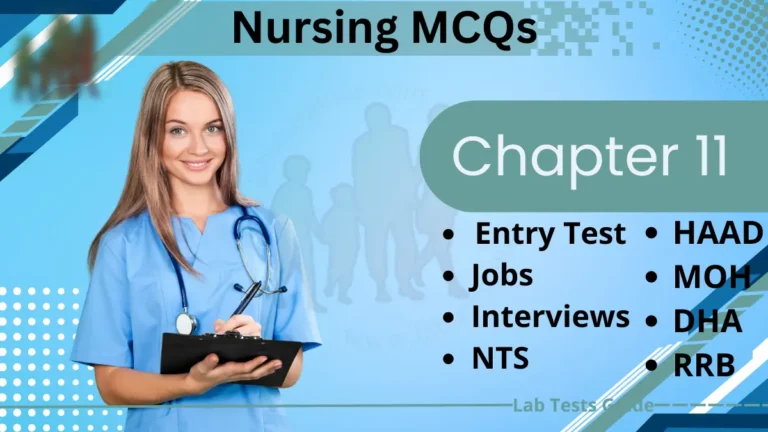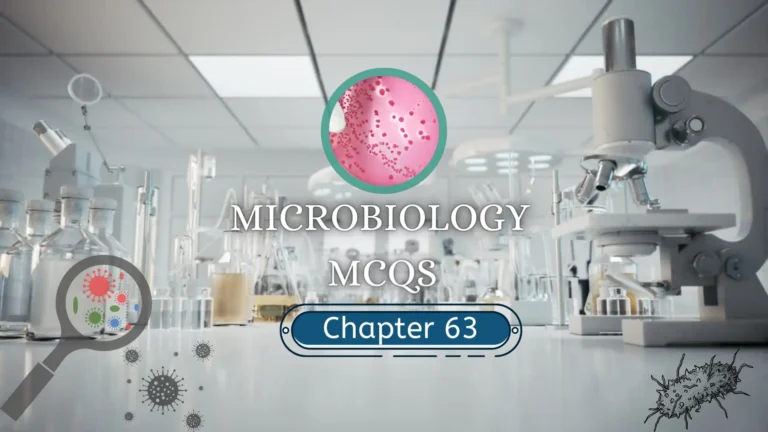5000 Plus MCQs for Lab Technician and Technologists are designed to test the knowledge and proficiency of laboratory professionals who work in the field of clinical laboratory science. These questions cover a wide range of topics related to laboratory science, including anatomy, physiology, microbiology, chemistry, and hematology.

3801 to 3850 MCQs for Lab Technician and Technologist Exam Preparation
If You like then share this to your friends and other social media.
If You have any question and suggestions then please Contact us Here
Questions 3801 to 3850
- What type of muscle is specialized for contraction?
A. Skeletal muscle
B. Cardiac muscle
C. Smooth muscle
D. Skeletal muscle and Cardiac muscle
E. Skeletal muscle, Cardiac muscle and Smooth muscle ✔️ - Where is mesothelium found?
A. Mucosa
B. Sub mucosa
C. Muscularis externa
D. Serosa ✔️ - What type of glands are the ceruminous glands?
A. Sebaceous glands
B. Eccrine sweat gland
C. Endocrine gland
D. Apocrine sweat gland ✔️
E. Oil gland - Which microscope makes things appear three dimensional?
A. Simple microscope
B. Compound microscope
C. Phase contrast microscope
D. Dissection microscope ✔️ - Which meninx covers the brain intimately?
A. Dura mater
B. Arachnoid
C. Pia mater ✔️
D. Dura mater and Arachnoid - What forms the brush border?
A. Microvilli ✔️
B. Stereocilia
C. Cilia
D. Keratinization - Which sensory receptor in the skin is NOT encapsulated?
A. Ruffini endings
B. Free nerve endings ✔️
C. Pacinian corpuscles
D. Meissner’s corpuscles - Where is the site of protein synthesis?
A. Ribosomes ✔️
B. Peroxisome
C. Microfilaments
D. Centrioles - What is the lining of the inner bone on the side which abuts the medullary cavity?
A. Perimysium
B. Periosteum
C. Perichondrium
D. Perineurium
E. Endosteum ✔️ - Which fiber type is seen in smooth muscle?
A. Red fibers
B. White fibers
C. Internmediate fibers
D. None of the above ✔️ - Which type of cartilage forms the skeleton of the fetus?
A. Hyaline cartilage ✔️
B. Elastic cartilage
C. Fibrocartilage
D. All of the above - What type of muscle contains centrally placed nuclei?
A. Smooth muscle
B. Cardiac muscle
C. Skeletal muscle
D. Smooth muscle and Cardiac muscle ✔️
E. Smooth muscle, Cardiac muscle and Skeletal muscle - Which of the following layers comprise the skin?
A. Epidermis
B. Dermis
C. Hypodermis
D. Epidermis and Dermis ✔️ - Which organelle is involved in lipid metabolism?
A. Rough endoplasmic reticulum
B. Smooth endoplasmic reticulum ✔️
C. Lysosome
D. Golgi apparatus - What type of tissue makes up the “Adam’s apple”?
A. Hyaline cartilage ✔️
B. Fibrocartilage
C. Elastic cartilage
D. Hyaline cartilage and Fibrocartilage - What are motor neurons?
A. Unipolar
B. Pseudounipolar
C. Bipolar
D. Multipolar ✔️ - What type of epithelium forms the epidermis?
A. Simple squamous epithelium
B. Simple cuboidal epithelium
C. Simple columnar epithelium
D. Stratified squamous epithelium ✔️ - Which type of cartilage forms the epiphyseal growth plate?
A. Hyaline cartilage ✔️
B. Elastic cartilage
C. Fibrocartilage
D. All of the above - What percent of the matrix of cartilage is water?
A. 0
B. 10-40
C. 40-60
D. 60-80 ✔️
E. 80-100 - What type of tissue lines most of the gastrointestinal tract?
A. Simple squamous epithelium
B. Simple cuboidal epithelium
C. Simple columnar epithelium ✔️
D. Stratified squanmous epithelium - Which of the following is NOT a function of the liver?
A. Conversion of glucose into glycogen
B. Storage of glycogen
C. Storage of bile ✔️
D. Storage of fat soluble vitamins - Which layer of the epidermis has cells which have keratohyaline granules?
A. Stratum basale
B. Stratum spinosum
C. Stratum granulosum ✔️
D. Stratum lucidum - What are the basophilic clusters of ribosomes and rough endoplasmic reticulum seen in neurons called?
A. Ganglion
B. Perikaryon
C. Astrocyte
D. Nissl ✔️ - What is the cell body ofa neuron called?
A. Ganglion
B. Soma ✔️
C. Astrocyte
D. Nissl - Which of the following is composed of smooth muscle?
A. Upper esophagus
B. Heart
C. Tongue
D. Biceps muscle
E. Walls of the visceral organs ✔️
- During the preparation of a routine H&E slide, what allows tha tissue to hold its from?
A. Fixation
B. Embedding in paraffin ✔️
C. Staining
D. Slicin8 - What is a characteristic of the cells in the epidermis of the skin?
A. Microvilli
B. Stereocilia
C. Cilia
D. Keratinizationn ✔️ - What is woven bone?
A. Cancellous bone
B. Compact bone
C. Dense bone
D. Immature bone ✔️ - What do you call the space where a chondrocyte sits in?
A. Space of Disse
B. Space of Mall
C. Vacuole
D. Lacuna ✔️ - What is the portion of the nail which is underneath skin?
A. Lunula
B. Eponychium
C. Matrix
D. Nail bed
E. Root ✔️ - Which cell is a macrophage found in the central nervous system?
A. Kupffer cells
B. Histiocyte
C. Dust cell
D. Langerhans cell
E. Microglia ✔️ - Which cell is the mature bonecell?
A. Chondrocyte
B. Chondroblast
C. Osteocyte ✔️
D. Osteoclast
E. Bone lining cell - The secretory piece of IgA is synthesized in –
A. T-cells
B. B-cells
C. Lymph nodes
D. Mucosal epithelium ✔️ - Membrane attack complex in complement pathway has-
A. C5b, C6
B. C6, C7
C. C8, C9
D. C5b, C6, C7, C8, C9 ✔️ - All of the following are TRUE about immunologic techniques EXCEPT-
A. ELISA can detect antigen and antibody both
B. Immunofluorescence test uses Fluorescein iso thiocyanate
C. Immunoblotting is also called as Northern blotting ✔️
D. Immunoferritin is used in Immunoelectron microscopy - Rheumatoid factor is-
A. IgD antibody against Fc fragment of IgG
B. IgG antibody against Fc fragment of IgG ✔️
C. IgM antibody against Fc fragment of IgM
D. IgE antibody against Fc fragment of IgM - At what temperature pasteurization by Flash method is done-
A. 125o C for 30 sec
B. 60o C for 5 min
C. 72o C for 15-20 sec ✔️
D. 120o C for 2 min - Phenol Co-efficient indicates-
A. Efficacy of a disinfectant ✔️
B. Dilution of a disinfectant
C. Quality of a disinfectant
D. Purity of a disinfectant - Psychrophillic bacteria can grow at temperatures-
A. 50-60o C
B. 20-40o C
C. 20o C ✔️
D. 90o C - Dark ground microscopy is needed for all EXCEPT-
A. Treponema pallidum
B. Borrelia recurrentis
C. Leptospira biflexa
D. Rickettsia prowazeki ✔️ - Which species of Streptococcus is known as Flesh eating bacteria-
A. Streptococcus pyogenes ✔️
B. Enterococcus faecium
C. Streptococcus mucilagenosus
D. Streptococcus sanguis - Which is the suitable test to check water bacterology-
A. Presumptive coliform count ✔️
B. Total plate count
C. Semiquantitative coliform count
D. Total fecal Streptococcus count - Which of the following is NOT true of C1 esterase inhibitor-
A. It inhibits Hageman factor
B. It inhibits plasmin
C. It is alpha-neuraminoglycoprotein
D. It inhibits the normal progress of complement cascade ✔️ - Which of the following is NOT an example of molecular mimicry-
A. Shigella flexneri and HLA B27
B. Cosackie B virus and Myocardium
C. Corynebacterium diphtheriae and glial cells ✔️
D. Mycobacterium tuberculosis and joint membranes - Which of the following is NOT true –
A. Alpha feto protein is found in hepatomas
B. Carcinoembryonic antigen is found in Colonic cancers
C. CA-135 is found in ovarian cancers ✔️
D. Prostate specific antigen is found in Prostate cancers - Which of the following is NOT a method for bacteriological examination of air-
A. Settle plate
B. Slit sampler
C. Air centrifuge
D. Pour plate method ✔️ - Noguchi’s medium is used for the culture of-
A. Borrelia ✔️
B. Leptospira
C. Brucella
D. Francisella - Obligate aerobes break down superoxides and hydrogen peroxide due to-
A. Thermonuclease
B. Superoxide dismutase and catalase ✔️
C. Phosphatase
D. Luciferase - Which of the following is NOT a recent diagnostic test in microbiology-
A. Limulus Amoebocyte Lysate(LAL) ✔️
B.Mass Spectrometry Immuno Assay
C. Matrix Assisted Laser Desorption/Ionisation(MALDI)
D. Chemiluminescence Immuno Assay - The schedule of post exposure active anti Rabies vaccination is-
A. 0,3,7,14 and 30 day optional
B. 0,7,14,30 and 90 day optional
C. 0,3,7,14,30 and 90 day optional ✔️
D. 0,7,14 and 30 day optional
The questions are typically designed to assess the technical skills and knowledge required for the laboratory profession, including the ability to analyze laboratory test results, perform laboratory procedures, and maintain laboratory equipment.
To prepare for these MCQs, candidates should have a thorough understanding of the key concepts and principles of laboratory science. They should also be familiar with common laboratory equipment and procedures, as well as laboratory safety protocols.
Candidates may also benefit from studying specific laboratory science textbooks or taking online courses that cover the material tested in the MCQs. Additionally, practicing sample MCQs and reviewing the answers can help candidates identify areas where they may need to improve their knowledge or skills.
Overall, the MCQs for lab technologists are designed to be challenging and comprehensive, requiring candidates to demonstrate a high level of proficiency in the field of laboratory science.
Possible References Used







